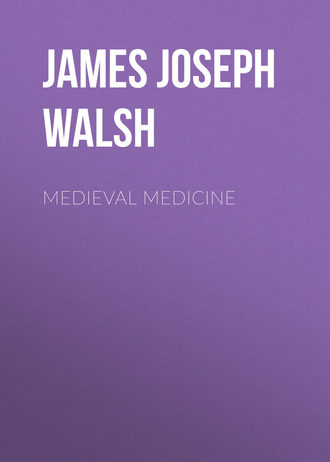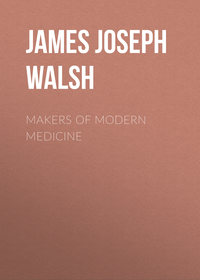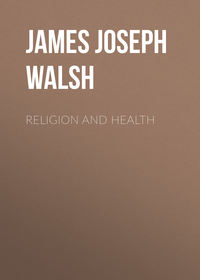 полная версия
полная версияMedieval Medicine
It may seem surprising that the first medical school should have arisen in the southern part of Italy, but for those who know the historical conditions it will seem the most natural thing in the world that this development should have come in this region. As we have said, touch with Greek has always been the most important factor for modern educational and intellectual development. Salerno was situated in the heart of that Greek colony in the southern part of Italy which came to be known as Magna Græcia. Apparently at no time during the Middle Ages was Greek entirely a dead language in this part of Italy, and there were Greek travellers, Greek sailors, and many other wanderers, who made their way along the shores of the Mediterranean at this time, and carried with them everywhere the stimulus that always came from association with the Greeks of Asia Minor and of the Grecian Islands and peninsula.
There were two other factors that made for the development of the medical school at Salerno. The first of these seems undoubtedly to have been the presence of the Benedictines, who had a rather important school at Salerno, and who were closely in touch with their great mother-house at Monte Cassino not far away. It was they who imparted the academic atmosphere to the town, and made it possible to gather together the elements for the university which gradually came into existence around the medical school, after that began to attract European attention.
The actual foundation of the medical school, however, seems to have been due to the fortunate accident that Salerno became a health resort, a place to which invalids were attracted from many parts of Europe because the climate was salubrious, and opportunities for obtaining the medical advice of men of many different schools of thought from all over the Mediterranean, and securing the Oriental drugs which were so much valued—as drugs from a distance always are—were there afforded. It is easy to understand that, especially in the winter-time, better-class patients from all over Europe would be glad to go down to the mild temperate climate of Salerno and spend their time there.
It has been pointed out that the first modern university, that of Salerno, had for a nucleus a medical school, representing man’s interest in his body as his primary intellectual purpose in modern history. The second modern university, that of Bologna, gathered around a law school representing man’s interest in his property—his second formal purpose in life. And the third, that of Paris, developed around a school of theology and philosophy, demonstrating that man’s intellectual interests rise finally to the consideration of his relations to his fellow-man and to God.
The first that we know definitely about the medical school of Salerno, the origin of which is difficult to trace, is concerned with Alphanus, usually designated “the First,” because there are several of the name. He was a Benedictine monk, distinguished as a literary man and known by his contemporaries as both poet and physician, who was afterwards raised to the Bishopric of Salerno. He had taught at Salerno in the Benedictine school there before becoming Bishop, and when exercising the highest ecclesiastical authority did much to encourage the development of Salerno. He states that medicine flourished in the town even in the ninth century, and there is an old chronicle published by De Renzi in his “Collectio Salernitana” in which it is said that the medical school was founded by four doctors—a Jewish Rabbi, Elinus; a Greek, Pontus; a Saracen, Adale; and the fourth a native of Salerno—each of whom lectured in his native language. This reads like a mythical legend that has formed around some real tradition of the coming of physicians from many countries. Puschmann in his “History of Medical Education” has suggested that the names are probably as much varied as the absolute truth of the facts. Elinus, the Jew, is probably Elias or Eliseus, Adale is probably a corruption of Abdallah, and Pontus should be probably Gariopontus.
There was a hospital at Salerno that was somewhat famous as early as the first quarter of the ninth century. This was placed under the control of the Benedictines; and other infirmaries and charitable institutions, similarly under the care of religious orders, sprang up in Salerno to accommodate the patients that came. The practical character of the teaching at Salerno, as preserved for us in the writings of the school, would seem to argue that probably those who came to study medicine here were brought directly in contact with the patients, though we have no definite evidence of that fact.
The most interesting feature of the medical school at Salerno is undoubtedly the development of legal standards of medical education in connection with the school. Before the middle of the twelfth century Roger, King of the Two Sicilies, issued a decree according to which preliminary studies at the University were required as a preparation for the medical school, and four years of medical studies were made the minimum requirement for the degree of doctor in medicine, which was, however, as we have said, not a licence to practise, but only a certificate authorizing teaching. There seemed to have been, even thus early, some further state regulations with regard to practice. About the middle of the next century, however, there came, through a law of the Emperor Frederick II., a still further evolution of legal standards for medical education and medical practice in the Two Sicilies. This law required that the student of medicine should have spent some years, probably the equivalent of our undergraduate training, in the university before studying medicine, and that he should then devote four years to medicine, after which, on proper examination, he might be given the degree of doctor—that is, teacher of medicine; but he must spend a further year of practice with a physician before he would be allowed to practise for himself.
This is such a high standard that, only that we have the actual wording of the law, it would seem almost impossible that it could have been evolved at this period in medical history. It actually represents the standard that we have climbed back to generally only during the past generation or two, and in the interval there have been many rather serious derogations from it. This law of the Emperor Frederick is, moreover, a pure drug law, regulating the sale of drugs and their purity, and inflicting condign punishment for substitution; in this regard also anticipating our most recent well-considered legislation. The penalty by which the druggist was fined all his movable goods for substitution, while the government inspector who permitted such substitution was put to death, would seem to us in the modern time to make the punishment eminently fit the crime. Almost needless to say, then, the law (see Appendix for full text) represents one of the most important documents in the history of medicine, particularly of medical education. The fee regulation included in it shows that medicine was looked upon as a profession, and was paid accordingly.
From Salerno come many of the traditions of the conferring of degrees which are still used in a large number of modern medical schools. Before receiving his degree, the candidate had to take an oath, of which the following were the principal tenets: “Not to contradict the teaching of his college, not to teach what was false or lying, and not to receive fees from the poor even though they were offered; to commend the sacrament of penance to his patients, to make no dishonest agreement with the druggists, to administer no abortifacient drug to the pregnant, and to prescribe no medicament that was poisonous to human bodies.”
It has sometimes been said that youths of tender age were admitted to the study of medicine at Salerno, and that many of them were given their degrees at the age of twenty-one. De Renzi’s discussion would seem to show that the usual age of receiving the degree was twenty-five to twenty-seven. As medical students had to have three years of preparatory studies in literature and philosophy, it would seem that they must have been rather mature on their admission to the medical schools.
De Renzi tells us that the medical school of Salerno was of great importance not only for medical education, but it acquired sufficient means to extend its benefits over the entire city. Gifts were made of statues to the churches, and especially to the shrine of St. Matthew the Apostle, situated here; monuments were set up, inscriptions placed and ample donations made to the various institutions of the city. The formal name of the medical school was Almum et Hippocraticum Medicorum Collegium. This is the first use that I know of the word almum in connection with a college, and may very well be the distant source of our term alma mater. The medical school was situated in the midst of an elevated valley which opened up on the mountain that dominates Salerno, and while enjoying very pure air must have been scarcely disturbed at all by the winds which can be blustery enough from the gulf. De Renzi says that in his time some of the remains could still be seen, though visitors to Salerno now come away very much disappointed because nothing of interest is left.
The most famous of the teachers at Salerno was Constantine Africanus, so called because he was born near Carthage. His life runs from the early part of the eleventh century to near its close, and he lived probably well beyond eighty years of age. Having studied medicine in his native town, he wandered through the East, became familiar with a number of Oriental languages, and studied the Arabian literature of science, and above all of medicine, very diligently. The Arabs, owing to their intimate contact with the Greeks in Asia Minor, had the Greek authors constantly before them, and Hippocrates and Galen have always roused men to do good work in medicine. Constantine seems not to have learned Greek, finding enough to satisfy him in the Arabic commentaries on the Greek authors, and probably confident, as all young men have ever been, that what his own time was doing must represent an advance over the Greek. He brought back with him Arabian books and a thorough knowledge of Arabian medicine. When he settled down in Carthage he was accused of magical practices, his medical colleagues being apparently jealous of his success—at least, there is a tradition to that effect to account for his removal to Salerno, though the immediate reason seems to have been that his reputation attracted the attention of Duke Robert of Salerno, who invited him to become his physician.
After Constantine’s time the principal textbooks of the school became, according to De Renzi, Hippocrates, Galen, and Avicenna. To these were added the Antidotarium of Mesue, and there were various compendiums of medical knowledge, quite as in our own time—one well known under the name of Articella. In surgery the principal textbook was the surgical works of the Four Masters of Salerno, which interestingly enough was the sort of combination work gathered from a series of masters that we are accustomed to see so frequently at the present day. De Renzi insists that there was much less Arabic influence at Salerno than is usually thought; and Gurlt more recently has emphasized, as we have said, the fact that the great textbooks of surgery which we have from Salerno contain not Arabisms, as might be expected from the traditions of Arabic influence that we hear so much of, but Græcisms, which show that here at Salerno there was a very early Renaissance, and the influence of Greek writers was felt even in the twelfth century.
Probably the best way to convey in brief form a good idea of the teaching in medicine at Salerno is to quote the Regimen Sanitatis Salernitanum, the Code of Health of the School of Salernum, which for many centuries was popular in Europe, and was issued in many editions even after the invention of printing. Professor Ordronaux, Professor of Medical Jurisprudence in the law school of Columbia College (now Columbia University, New York), issued a translation of it in verse,3 which gives a very good notion of the contents and the spirit and the mode of expression of the little volume.
The Regimen was written in the rhymed verses which were so familiar at this time. Many writers on the history of medicine have marvelled at this use of verse, but anyone who knows how many verse-makers there were in the twelfth and thirteenth centuries all over Europe will not be surprised. It used to be the custom to make little of these rhymed Latin verses of the Middle Ages, but it may be well to recall that in recent years a great change has come over the appreciation of the world of literature in their regard. The rhymed Latin hymns of the Church, especially the Dies Iræ, the Stabat Mater, and others, are now looked upon as representing some of the greatest poetry that ever was written. Professor Saintsbury of the University of Edinburgh has declared them the most wondrous wedding of sense and sound that the world has ever known. The Regimen Sanitatis of Salerno is of course no such poetry, mainly because its subject was commonplace and it could not rise to poetic heights. A good deal of the deprecation of its Latinity might well be spared, for most of the mistakes are undoubtedly due to copyists and interpolation. The verses not only rhyme at the end, but often there are internal sub-rhymes. This too was a very common custom among the hymn-writers, as the great sequence of Bernard of Morlaix, so well known through its translations in our time, as “Jerusalem the Golden” attests.
The Regimen was not written for physicians, but for popular information. It seems to have been a compilation of maxims of health from various professors of the Salernitan School. Nothing that I know shows more clearly the genuine knowledge of medicine, and the careful following of the first rule of medical practice non nocere to which Salerno had reached at this time, than the fact that this popular volume contained no recommendation of specific remedies, but only health rules for diet, air, exercise, and the like, many of which are as valuable in our time as they were in that, and very few of which have been entirely superseded—together with some general information as to simples, and a few details of medical knowledge that would give a convincing air to the compilation.
The book was dedicated to the King of the English, Anglorum regi scribit schola tota Salerni, and in the translation made by Professor Ordonaux begins as follows:
If thou to health and vigour wouldst attain,Shun weighty cares—all anger deem profane,From heavy suppers and much wine abstain.Nor trivial count it, after pompous fare,To rise from table and to take the air.Shun idle, noonday slumber, nor delayThe urgent calls of Nature to obey.These rules if thou wilt follow to the end,Thy life to greater length thou mayst extend.4Evidently it was rather easy to commit such rhymes to memory, and this accounts for the fact that we have many different versions of the Regimen and disputed readings of all kinds. These medieval hygienists believed very much in early rising, cold water, thorough cleansing, exercise in the open air, yet without sudden cooling afterwards. The lines on morning hygiene seem worth while giving in Ordonaux’s translation.
At early dawn, when first from bed you rise,Wash, in cold water, both your hands and eyes.With brush and comb then cleanse your teeth and hair,And thus refreshed, your limbs outstretch with care.Such things restore the weary, o’ertasked brain;And to all parts ensure a wholesome gain.Fresh from the bath, get warm. Rest after food,Or walk, as seems most suited to your mood.But in whate’er engaged, or sport, or feat,Cool not too soon the body when in heat.The Salernitan writers were not believers in noonday sleep, though one might have expected that the tradition of the siesta in Italy had been already established. They insist that it makes one feel worse rather than better to break the day by a sleep at noonday.
Let noontide sleep be brief, or none at all;Else stupor, headache, fever, rheums, will fallOn him who yields to noontide’s drowsy call.They believed in light suppers—
Great suppers will the stomach’s peace impair;Wouldst lightly rest, curtail thine evening fare.With regard to the interval between meals, the Salernitan rule was, wait until your stomach is surely empty:
Eat not again till thou dost certain feelThy stomach freed of all its previous meal.This mayst thou know from hunger’s teasing call,Or mouth that waters—surest sign of all.Pure air and sunlight were favourite tonics at Salerno—
Let air you breathe be sunny, clear, and light,Free from disease or cess-pool’s fetted blight.Taking “a hair of the dog that bit you” was, however, a maxim with Salernitans for the cure of potation headaches.
Art sick from vinous surfeiting at night?Repeat the dose at morn, ’twill set thee right.The tradition with regard to the difficulty of the digestion of pork, which we are trying to combat in the modern time, had already been established at Salerno. The digestibility of pork could, however, be improved by good wine.
Inferior far to lamb is flesh of swine,Unqualified by gen’rous draughts of wine;But add the wine, and lo! you’ll quickly findIn them both food and medicine combined.Milk for consumptives was a favourite recommendation. The tradition had come down from very old times, and Galen insisted that fresh air and milk and eggs was the best possible treatment for consumption. The Salernitan physicians recommended various kinds of milk, goat’s, camel’s, ass’s, and sheep’s milk as well as cow’s. It is probable, as I pointed out in my “Psychotherapy,” that the mental influence of taking some one of the unusual forms of milk did a good deal to produce a favourable reaction in consumptives, who are so prone to be affected favourably by unusual remedies. The Regimen warned, however, that milk will not be good if it produces headache or if there is fever. Apparently some patients had been seen with the idiosyncrasy for milk, and the tendency to constipation and disturbance after it which have been noted also in the modern time.
Goat’s milk and camel’s, as by all is known,Relieve poor mortals in consumption thrown;While ass’s milk is deemed far more nutritious,And e’en beyond all cow’s or sheep’s, officious.But should a fever in the system riot,Or headache, let the patient shun this diet.Salerno’s common sense with regard to diet is very well illustrated by a number of maxims. Diet tinkering was not much in favour.
We hold that men on no account should varyTheir daily diet until necessary:For, as Hippocrates doth truly show,Diseases sad from all such changes flow.A stated diet, as it is well known,Of physic is the strongest cornerstone—By means of which, if you can nought impart,Relief or cure, vain is your Healing Art.They believed firmly that many of the conditions of eating were quite as important as the diet itself, and said:
Doctors should thus their patients’ food revise—What is it? When the meal? And what its size?How often? Where? lest, by some sad mistake,Ill-sorted things should meet and trouble make.They recommended the various simples, mallow, mint, sage, rue, the violet for headache and catarrh, the nettle, mustard, hyssop, elecampane, pennyroyal, cresses, celandine, saffron, leeks—a sovereign remedy for sterility—pepper, fennel, vervaine, henbane, and others. There were certain special affections, as hoarseness, catarrh, headaches, fistula, for which specific directions for cure were given. Here for instance are the directions to be given a patient suffering from rheum or catarrh. The verses conveyed interesting information with nice long names for the various affections, as well as the directions for its management.
Fast well and watch. Eat hot your daily fare,Work some, and breathe a warm and humid air;Of drink be spare; your breath at time suspend;These things observe if you your cold would end.A cold whose ill-effects extend as farAs in the chest, is known as a catarrh;Bronchitis, if into the throat it flows;Coryza, if it reach alone the nose.The Regimen conveyed a deal of information in compact form. It gives the number of bones in the body as 219 with 32 teeth, and the number of veins as 365, this number being chosen doubtless because of some supposed relation to the number of days in the year. It contains also a good brief account of the four humours in the human body—black bile, blood, phlegm, and yellow bile; and of the four temperaments—the sanguine, the bilious, the phlegmatic, and the melancholy. These four temperaments were discussed at considerable length by all the psychologists and most of the writers on religious life for centuries afterwards, largely on the basis of the information conveyed by the Salernitan handbook. There are descriptions of the symptoms of plethora or excess of blood, of excess of bile, of excess of phlegm, and excess of black bile. The little volume finally contains discussions as to bleeding, its indications, contraindications, as in youth—“Ere seventeen years we scarce need drawing blood”—and in old age; and then of the mode of practising it, and the place whence the blood should be drawn to relieve different symptoms.5
Salerno impressed itself much more deeply on surgery than on medicine, for the magnificent development of medieval surgery, the knowledge of which has proved so surprising in our day, began down at Salerno. Some of the details of this phase of Salernitan accomplishment are given in the chapter on Medieval Surgeons of Italy. Roger and Roland and the Four Masters were great original founders in a phase of medical science that proved extremely important for the next three or four centuries. Undoubtedly the presence of a hospital at Salerno, where there were gathered a number of the chronic cases from all over Europe, most of them of the better-to-do classes looking for ease from their ills, gave the incentive to this development. When the natural means of cure, tried for a considerable time, failed, recourse was had to surgery for relief, and often with excellent results. This chapter on Salerno’s history shows how thoroughgoing was the effort of the members of the faculty of the medical school to develop every possible means of aid for their patients, even when that required pioneer work.
Pagel’s appreciation of Salerno’s place in the history of medicine, in his chapter on Medicine in the Middle Ages in Puschmann’s “Handbuch Der Geschichte der Medicin,” Berlin, 1902, gives in very brief space a summary of what was accomplished at Salerno that emphasizes what has been said here, and his authority will confirm those who might possibly continue to doubt of any institution of the Middle Ages having achieved so much. He said:
“If we take up now the accomplishments of the School of Salerno in the different departments, there is one thing that is very remarkable. It is the rich, independent productivity with which Salerno advanced the banners of medical science for hundreds of years, almost as the only autochthonous centre of medical influence in the whole West. One might almost say that it was like a versprengten Keim—a displaced embryonic element—which, as it unfolded, rescued from destruction the ruined remains of Greek and Roman medicine. This productivity of Salerno, which may well be compared in quality and quantity with that of the best periods of our science, and in which no department of medicine was left without some advance, is one of the striking phenomena of the history of medicine. While positive progress was not made, there are many noteworthy original observations to be chronicled. It must be acknowledged that pupils and scholars set themselves faithfully to their tasks to further, as far as their strength allowed, the science and art of healing. In the medical writers of the older period of Salerno, who had not yet been disturbed by Arabian culture or scholasticism, we cannot but admire the clear, charmingly smooth, easy-flowing diction, the delicate and honest setting forth of cases, the simplicity of their method of treatment, which was to a great extent dietetic and expectant; and while we admire the carefulness and yet the copiousness of their therapy, we cannot but envy them a certain austerity in their pharmaceutic formulas, and an avoidance of medicamental polypragmasia. The work in internal medicine was especially developed. The contributions to it from a theoretic and literary standpoint, as well as from practical applications, came from ardent devotees.”











